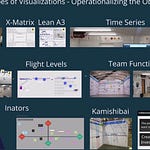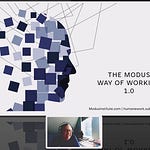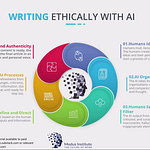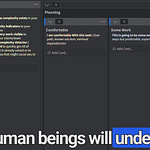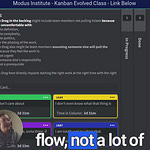Work isn’t just a task.
I watched a project manager have what I can only describe as a quiet breakdown in her beautiful 18th floor office. She was surrounded by three laptops, two phones, and a set of kanban boards so full of different colors and shapes you needed a 2 hour conversation just to figure out what was going on.
"I’m seeing my work, but I can't remember what I'm supposed to be doing," she said. "I mean, I know I'm busy. I'm always busy. We are always getting things done, but there’s too much conversation once we start. There’s too many questions. I can’t focus."
This is the reality of work and leadership today. We've become incredibly sophisticated at starting things. We’ve been amazing at inventing new things we could be doing. There are literally limitless things we could be doing. We've mastered the art of being busy. But somewhere between "let's do this" and "we did this" something fundamental breaks down.
We've lost the ability to see our work as it actually exists: not as neat project plans or color-coded calendars, but as the messy, human, learning-filled journey it really is.
If you're nodding along, you're sharing my world where work is always an endless cycle of starting without finishing, reacting without reflecting, and moving without meaning. But there are ways to deal with this … and no, it’s not another productivity app or mindless rule about "crushing it."
Yes, it involves visualizing your work and yes, it involves Kanban or Personal Kanban…
Real Work is More Than You Planned For
People talk about productivity hacks and project management tools, and we love setting up our task boards with neat columns. But we're missing something fundamental: we're optimizing for busy instead of optimizing for human.
Here's what I mean. When was the last time you finished something at work and felt genuinely satisfied? Not just relieved that it was over, but actually proud of what you created and how you created it? When you could look back and say, "That was worth doing, we did it well, and I understand why it mattered"?
You're not alone in having more bad examples than good. As humans, we've built work systems that are incredibly good at keeping us moving but terrible at helping us feel we’ve done something worthwhile.
For leaders reading this: When someone on your team feels genuinely satisfied with their work, it means they know what they did, why it mattered, and that it was delivered with care. This isn't a nice-to-have, this is your most reliable indicator of quality work…of effectiveness. When people feel good about what they've created, they've done good work. Pushing productivity or efficiency will always leave you with shoddy output. Pushing for effectiveness and measuring satisfaction will always result in a self-optimizing team (which increases the productivity and efficiency you wanted without the quality penalties).
For everyone else: You feeling like your work was worthwhile and well-executed isn't being precious or perfectionist. It's the most honest measure of effectiveness we have. When something doesn't feel right to you, it's usually because something important was missing: clarity about the goal, support during execution, or time to reflect on what you learned. This is what being a professional is all about.
How We Actually Experience Work
When our work is invisible to us and others, it exists in one state: overwhelm. Everything feels and is equally urgent, nothing feels truly important, and we lose track of what we've actually accomplished.
But when we make our work visible (really visible, not just "task management visible") something interesting happens. We see our work in its natural rhythm: the figuring-out phase, the doing phase, and the learning phase.
Most people (even people doing Kanban) focus only on the doing. They ask "What are you working on?" But that's like asking a chef what's on their cutting board while ignoring the menu planning, the moment when they taste the dish to see if it's ready to serve, and the wait to see if the dish is sent back.
The truth is, meaningful work has three essential phases, and we need to honor all of them if we want to feel good about what we create together. To understand this and make it useful, we need to name things. I’ve chosen WIN, WIP, and WIR.
WIN, WIP, and WIR
WIN - Work in Navigation (or Initiation, or Intake)
You cannot win without a plan.
This is where work begins its journey. Not just the obvious stuff like "new project approved" but all the messy, human work of figuring out what we're actually doing. The conversations, the clarifications, the slow dawn of understanding what this thing really needs. The prioritization and re-prioritization. Stop starting – start finishing starts here. This is more than a To Do column, these are columns that help you build a structure for doing the right work at the right time. This is where we ensure that when WIN becomes WIP, it is ready for the people doing it to focus and finish.
WIP - Work in Process (or Progress)
You cannot finish well without focus.
I should hope we all know this one. Personal Kanban only had two rules at limiting WIP was one of them. It was called out because it’s the hardest (and we can do it without a good WIN before the WIP). Over the years we’ve found that limiting WIP isn't just a number "currently doing." It's the active wrestling with reality. It's where our plans meet the world and things get complicated. It's where we discover what we didn't know we didn't know. WIP is where the real work happens, and it's messier than any project plan ever imagined. Our WIP Whisperer class and our Toxic Waste class both deal with this head-on. When we don’t plan or review well, we create increasing amounts of unnecessary WIP with additional meetings, re-work, tossed-out work, coordination costs, discussed and re-discussed decisions, proving that tasks can’t be completed as assigned, and so much more. For almost all teams, most WIP is not visualized, but is a reaction to failure to create completable work in the first place.
WIR - Work in Review
Your work either improves, or it decays.
I see painfully few teams or people respect WIR. They have a DONE column and think they are DONE. They will create definitions of DONE that are laughable in that they focus on when the work stops, not when the responsibility for the work ends or value for the customer is realized. Then people are surprised when the “bad work” listed in the WIP section above shows up. WIR is the entire reason to have a kanban…not DOING, but what happens next. Planning and Review are professionalism, In-Process is just execution. WIR isn't just checking boxes or getting sign-offs. It’s not putting in tickets for a retrospective that happens later. It’s not a Done column. It's the space where we learn from what has been released to the customer. Where we ask not just "is it done?" but "how is it doing?" It's where individual effort becomes team wisdom. It is where continuous improvement becomes continuous. It’s where we remember we are responsible for our work after the DONE column.
Why This Matters
Yeah yeah, I hear you, "Great, another three-letter acronym (or two) for my collection." But this has been a thing ever since we created kanban, and we’ve never stated it well. WIN, WIP, WIR point out what’s there, hidden beneath the chaos. We can’t calm the chaos without focusing harder on planning and reviewing. (For geeks I could go into PDSA here, but we can do that elsewhere).
For the rest of us…think about the last time your team felt truly synchronized. I'm know for a fact it wasn't because you all followed the same process or framework perfectly. It was because you were all clear about where things stood and why. You knew what was just beginning (WIN), what was actively in motion (WIP), and what was ready to teach you something (WIR). <- Not Done…
Hidden Information = Stress…When work is invisible, information is hidden and stress takes over.
Shared Information = Focus…When we can see the full landscape of our work (not just what's "in progress" but what's finding its footing and what's teaching us lessons) everything changes.
The Necessary Art of Making Work Visible
I want all teams to do the right work at the right time in a way that works for them.
WIN, WIP, WIR doesn’t need permission for you to start using it. You don't need to convince anyone or change any systems. Just don’t ignore it. You can begin with three columns on a whiteboard, three sections in a notebook, or three areas on a shared digital board.
Start with WIN (Honesty in what’s coming)
Notice when something new enters your world. Not just the formal requests, but the questions that need exploring, the conversations that reveal hidden needs, the problems that are just beginning to surface. Give these things space to breathe before they become urgent.
Be honest about WIP (Honesty in what you are doing)
Stop pretending you're only working on three things when you're really buried in fifteen. The “official work” on the board is not your real work in progress. Make all the work visible, even the stuff you're doing “because you have to”. Especially that stuff. The emails, the quick questions, the "this will just take a minute" requests…all of that belongs somewhere you and everyone else can see it.
Create space for WIR (Honesty in what you’ve released)
This is the one most teams miss and it's the most important. When something moves out of active work, don't just celebrate and move on. Watch the work get used and ask: How is it doing? How is the customer better off? Is anyone using it? Did it hurt to do this? Do we have to do it again? What did we learn? What surprised us? What worked better than expected? Let the work teach you before it disappears into memory. And no, it is not the product manager or the product owner’s job to care about your work, it’s yours.
Use This Now
Right now, wherever you are, take a moment to think about your work and what stage it is in. Think about what you have been overlooking for the actual work involved in a task. Think about the after-release maintenance you are doing or ignoring and the impact those have on your day. Then, make that all visible, make it part of your Personal Kanban.
And that's when WIN, WIP, WIR becomes not just a way of organizing tasks, but a way of creating work that's both effective and humane.



